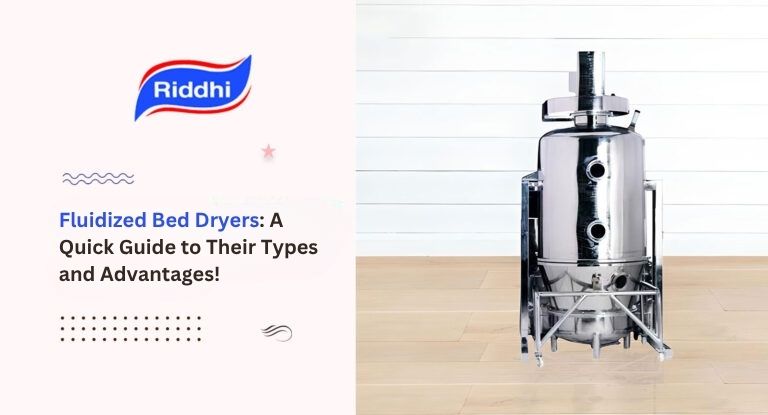Fluidized Bed Dryers: A Quick Guide to Their Types and Advantages!

Strong 8k brings an ultra-HD IPTV experience to your living room and your pocket.
Fluidized bed dryers are pieces of industrial equipment that use hot air to suspend powders and grains in order to decrease their moisture content. This generates a fluidized condition in which particles are agitated and exposed to hot air, allowing for quick and uniform drying. Efficient and effective drying of bulk materials is a fundamental component of contemporary industrial processes, regardless of industry.
The following is a complete overview of these industrial drying systems, including how they work, their types, what material properties impact the drying process, significant benefits, and popular applications.
Fluidized Bed Dryers: Different Types
Vertical Fluidized Bed Dryer.
A Vertical Fluidized Bed Dryer (VFBD) is an industrial dryer that uses a vertical column loaded with granular material. It works by forcing hot air down the bottom of the column, causing the material to become fluidized or suspended in the air stream. The dryer is composed of SS316, an austenitic chromium-nickel stainless steel with a purposeful addition of molybdenum, which increases general corrosion.
This sort of fluidized-bed dryer is also known as a batch-type dryer. As the name implies, a full batch of goods is dried. The air stream is supplied into this dryer by a fan located in the upper portion of the unit. This air is heated in an air heater and sent upward through the material in the drying chambers. A bag collection fitter is placed at the top of the chamber, lifting all material and allowing only air to flow through.
A detachable bowl is primarily used for charging and discharging the material and comes in a variety of sizes, ranging from 5 kgs (for R&D) to 650 kgs (for commercial application).
Horizontal Fluidized Bed Dryer.
Horizontal FBD is more suited to drying bigger batches that require a continuous drying cycle. Typically, these dryers need a significant expenditure to acquire, run, and maintain. This FBD is made up of a horizontal vibrating conveyor dryer that holds wet material along its length.
This type of fluidized-bed dryer is also known as a continuous dryer since the drying operation is ongoing. This dryer has a movable bed loaded with trays carrying the material to be dried. The trays' bases are perforated, allowing hot air to flow readily through them. These trays move across several rooms of a planet. Each chamber contains an air intake at the bottom and an air exit at the top. The pipe's outlets are all open, allowing the air to be exhausted. Each chamber receives an air supply, however, the temperature of the hot air entering the room steadily rises.
First, air flows through the opening, and the substance is propelled upwards like a fluid. The air is then evaporated and filtered in the next chamber, but the granular air is eventually left behind when it is dried.
The fluidized bed dryer may be separated into many zones with independent control of airflow and temperature, allowing drying to proceed at the optimal rate in each step without losing efficiency or injuring heat-sensitive fabrics.
How Do Fluidized Bed Dryers Work?
Fluidization, which causes the material to act like a liquid and remain suspended, is accomplished by striking the correct balance between upward air flow and particle weight. This is accomplished by moving air through a permeable layer of solids via a perforated plate at the bottom of the drying tank. Unlike static dryers, fluidizing materials have a much larger surface area exposed to the air flow.
The FBD Working Explained Below:
The primary requirement for an air heating unit is to heat the main tower. Compression air examination ensures that joints produced by inflation gaskets are leak-proof. Loading, Air Inlet, Fluidization, Drying, and Shaking of Filter Bags are steps included in the working process of FBDs.
Loading
The material to be dried, whether granular or powder, is deposited on a perforated plate or bed in the dryer.
Air Inlet
As the blower becomes operational, it constantly sucks air from the Air Heating Unit and into the tower via the lower plenum.
Fluidization
Hot air or gas enters the perforated plate, generating an upward circulation that lifts and suspends particles. This results in a fluidized condition in which the particles act like liquids, allowing for effective heat transmission and mixing.
Drying
The drying process continues in three phases till the endpoint is met.
Preheating
Wet particles linger in both dry and hot air currents. Surface moisture evaporates when heat travels through the particle's body when it is heated conventionally. The moisture loss during preheating is reduced, while the temperature of the bed rises consistently.
FBD is based on the fluidization of feed material. In the fluidized bed dryer, the particles are suspended in a mobile gas stream (Hot Air); the air acts as a boiling liquid, lifting the particles higher before falling back down. This approach allows for improved heat and mass transmission. This combination of solid particles and air behaves like a liquid, hence, the solid is said to be fluidized. This approach is more effective for drying granular particles. This process surrounds each granule with heated air, efficiently drying the substance.
Advantages of the Fluidized Bed Dryer (FBD):
- The dryer's fast drying time and effective mixing action prevent hot spots and allow for greater drying temperatures.
- A fluidized bed dryer (FBD) dries in 30 to 40 minutes, whereas traditional tray and truck dryers take 12-24 hours.
- The thermal efficiency of FBDs is five times that of conventional ones.
- FBD provides a more practical drying option for thermolabile compounds due to its reduced drying durations.
- FBD is quite adaptable in operation, since it may be used in both continuous and batch mode.
- Delivers great output while taking up less space in a given area.
Conclusion
Fluid bed dryers are a flexible and dependable type of drying equipment that is widely utilized in many different industries. Understanding their operating principles, material properties that influence the drying process, prevalent applications, and significant benefits provides insight into why these industrial drying systems have become so popular.
Note: IndiBlogHub features both user-submitted and editorial content. We do not verify third-party contributions. Read our Disclaimer and Privacy Policyfor details.


